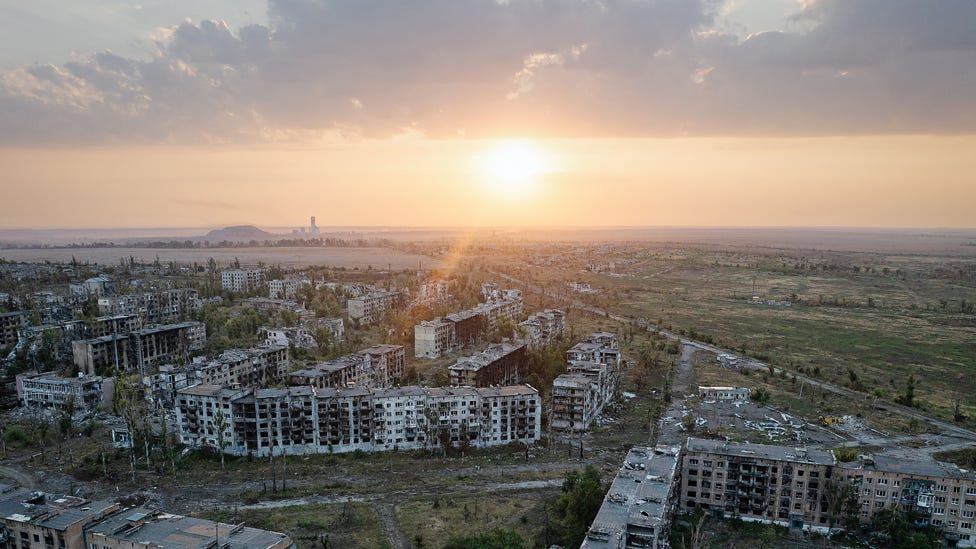Ukraine war: The cost of Vuhledar’s capture
Two of Russia’s elite marine units appear to have lost 40% of their men in the battle for the town. Russian war dead since the full-scale invasion may be as high as 183,500.

Russia has been trying to seize the small but militarily important Donbas mining town of Vuhledar since the start of the full-scale invasion. This week, Ukraine acknowledged the loss of its blasted ruins.
At this point, it is impossible to determine how many lives the Kremlin spent in taking Vuhledar. But a BBC analysis suggests that the 155th and 40th Marine Brigades alone may have lost more than 2,100 men – killed, missing or severely wounded. That would amount to 40% of their pre-war strength.
Alongside the Mediazona news outlet, and in collaboration with a team of volunteers, the BBC has managed to confirm the names of 72,004 dead soldiers since the fighting began, the majority of whom had no association with the military at the outset of the war.
The true number of fallen is of course much higher than can be discovered through open sources. The military experts we have consulted suggest the figures we have reached through analysing obituaries, war memorials and cemeteries may account for 45-65% of the real total killed. The growth in the death toll also fluctuates or is delayed by the time it takes for casualties to be removed from battles which are ongoing or frontlines that remain hazardous.
Bringing this all together, and including the dead from the self-proclaimed Luhansk and Donetsk ‘People’s Republics’, the BBC believes the war dead to number 131,800 – 183,500.
Catastrophic losses among the marines
Vuhledar is seen as an important location from a military standpoint: the town is situated on high ground, allowing the Ukrainian army a clear view to strike enemy supply routes.
The heaviest, bloodiest battles here took place in the autumn of 2022 and last winter. Elite marine units from the 155th and 40th ‘Black Beret’ brigades were deployed to take Vuhledar by storm, with support from infantry fighting vehicles and tanks, backed by conscript and volunteer troops from motorised rifle units.
Open source data enables us to establish the killing of at least 211 marines from the 155th Marine Brigade, with another 42 missing in the assault operations. For comparison, this is almost four times greater that the brigade’s total casualty figures over a decade of fighting in Chechnya.
Among the dead are 19 officers, including battalion commander Tsyren Lubsanov.
Fighting with them were men from the 40th Marine Brigade, based in Petropavlovsk-Kamchatsky, in the very far east of Russia. Open source data reveals the deaths of at least 72 soldiers and officers from their number.
The assignment of ‘Storm Z’ units, composed of prisoners from Russian penal colonies, to these two elite ‘Black Beret’ brigades is an indirect indication of the severity of the losses sustained.
"I am searching for a fighter called Sergei Valebny. He left Correctional Colony No. 17 in Murmansk. He was attached to the 40th Marine Brigade,” the wife of one soldier writes in a social media chat group for relatives.
“On June 21, 2023, he went on a mission in the Vuhledar area and hasn't been in contact since. On June 25, his comrades informed me of his death. A shell struck him —and his body, those who saw it say, was ripped apart. But there is no official information.”
She received several messages in reply from other wives and mothers of convicts who had despatched to the frontline along with the marines. They said they had not heard from their sons and husbands for months, either.
On August 28, 2023, as part of another attempt to break through to Vuhledar, three more prisoners were killed: Pavel Novikov, Alexander Anfimov, and Alexander Pushkin. All three had been recruited to the frontlines from Correctional Colony No.5 in the Arkhangelsk region of Russia’s far north.

The casualty figures we have established for the two marine brigades are based merely on deaths reported in the official media of the Primorsky and Kamchatka regions, or in social media posts, when the units the men belonged to could be confirmed.
But the true number of ‘Black Berets’ killed in capturing Vuhledar may be twice as high – as many as 570 men. We base this conclusion on a study of photographs from cemeteries where the men were based. We noted that on average the images include those named publicly as well as a broadly similar number of military graves for men whose deaths were not mentioned in the media or on social networks.

Several dozen such graves were marked with banners from the 155th and 40th Marine Brigades, but in many other cases there was no confirmation of the unit concerned, and so we did not include them in the ‘Black Beret’ casualty list. Adding those who are missing, and most likely to have perished by now, the actual number of marines killed in the assaults on Vuhledar could rise to 700.
The number of wounded is harder to estimate. But one can examine documents related to compensation payments made to those discharged because of their injuries. Calculations made by Mediazona and the Meduza news outlet suggest that for every Russian soldier killed, there may be 1.7 to 2 wounded severely enough that they cannot return to the front. This would generate a total of up to 1,400 from the two units in question, bringing the number of ‘Black Berets’ taken out of the ranks during the battle for Vuhledar to 2,100.
Western military analysts put the pre-war strength of the 155th Marine Brigade at approximately 2,900 men. The 40th boasted about 2,400. The fighting for Vuhledar alone, discounting any other operations they were involved in, may have incapacitated up to 40% their manpower. But theirs were not the only units to suffer losses in the prolonged assaults on the Donetsk mining town.
The ambush of the ‘Alga’ battalion
The fighting for Vuhledar also decimated the ‘Alga’ motorised rifle battalion, formed in Tatarstan from volunteer contract soldiers after the full-scale invasion of Ukraine began.
Alga’s Third Company was ambushed near Vuhledar on February 6th, losing at least 27 soldiers killed and more than 60 wounded. A dozen or so are still listed as missing. Despite this serious setback, the battalion returned to the same forested area four more times, losing another seven soldiers and suffering roughly another 20 wounded.
Survivors’ stories from that day highlight why Russia has lost so many men in taking Vuhledar. The men say they were driven in infantry vehicles produced in the 1970s, some of which broke down en route. Added to which, the vehicles were deployed in a column, offering an easy target for ambush. On February 6th, the first and penultimate vehicles were taken out, bringing the column to a halt, and leaving troops riding on top of the armour to be picked off by Ukrainian gunners hiding in a nearby treeline.
Another reason given for the heavy losses was a failure to use artillery effectively before infantry assaults. The Ukrainian army had constructed widespread heavily fortified defenses around Vuhledar, riddled with trenches and underground tunnels. Russian troops were often sent to attack such positions head-on, in the total absence of prior bombardment.
Even when artillery support was available, fire correction was poor due to communication problems – something that has bedevilled Russian operations, especially at the front, throughout the war.
In the case of the ‘Alga’ ambush, survivors say, when mortar support was called in, it struck their own troops first, causing additional losses. It took some time to be redirected onto the Ukrainian positions.
The real price of an assault
The consequences of this type of assault operation go beyond the total number of dead and severely wounded: it is also important to consider who exactly was removed from combat. Our list of confirmed marine casualties includes a battalion commander, two deputy battalion commanders, and five company commanders. It will take at least seven to eight years of training to bring up adequate replacements for men occupying such specialised roles.
The depletion in the ranks of experienced officers and key leadership figures represents a significant blow to the operational capacity of such units - affecting coordination, decision-making, and overall effectiveness in battle. The loss of high-ranking and skilled personnel has an overall knock-on effect on Russia’s ability to sustain effective military operations, particularly in future complex, high-intensity environments similar to those at Vuhledar.
In the Russian army, it is typically only officers who are trained to synchronise action with other military branches, such as artillery units. Tactical cohesion in battle is therefore disproportionately affected by their death or injury, especially when it comes to lower-ranking officers from lieutenant to captain. Put simply, units lacking such men fall into disarray, hindering one another’s moves at the front, and becoming easy prey to enemy fire.
In early 2023, the internet was awash with video shot near Vuhledar of the chaotic actions of combat vehicles of the 155th Marine Brigade. One sequence showed an infantry vehicle struggling to get out of an exposed position while under attack, running over several of their own men in the process.
As for the 15,000 or so people who lived in Vuhledar before the war, the Russian offensives have caused the near-total destruction of their town - and countless human tragedies.

“We have been ‘liberated’ from normal life, from our work, from our families,” Marina told the BBC. She was forced to abandon her home.
“We were not ‘oppressed’. We didn’t need to be ‘liberated’.”
Our method
New names of the dead and photographs from funerals are published every day throughout Russia. Their identities are disclosed by the heads of Russia’s regions, representatives of district administrations, local media, educational institutions where the deceased had studied, or by relatives.
We consider death confirmed if its announced by an official Russian source or the Russian media, or if it is made public by relatives. Other sources are also counted if they are accompanied by photos of the funeral.
Generally we do not include losses by the DNR and LNR ‘republics’, though if a Russian citizen has volunteered to go to war in such units, we do add him to the count.
The kind of military unit concerned is determined either by reports of where the deceased served or by the insignia on his uniform. While conscripts, volunteers and convicts are not separate types of troops, we categorise them independently in order to compare losses against those borne by professional fighting units of the regular army.
The category ‘Other Troops’ in our graphics covers air defence servicemen, Nuclear Biological and Chemical troops, communications specialists, air force ground troops, Interior Ministry servicemen, transport troops and the military police.
Read this story in Russian here.
English version edited by Chris Booth.
Volunteers dying as Russia’s confirmed war dead tops 70,000
BBC Russian findings, published by BBC News online, show Russia's losses in its war against Ukraine passing a historic mark.
Here's something you didn't expect: Invite your friends to read us and get a reward
Thank you for reading The Best of BBC News Russian – in English — your support allows us to keep doing this work.








I am a Russian, living in America for many years, but sill cannot understand the slave conscience of Russians who not to protest the invasion of their slavic relative- Ukraine under their criminal leader- Putin.